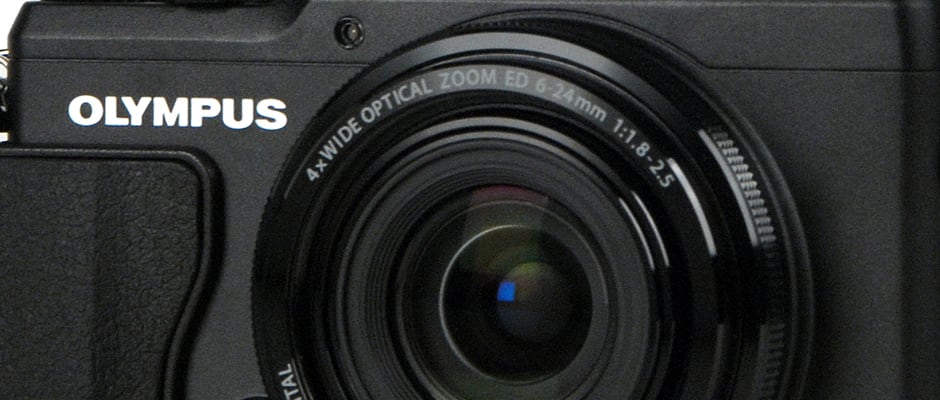Pros
Cons
Design & Usability
Just looking at the Stylus XZ-2, it's easy to see the influence that Olympus's PEN series has had on the external design. Especially when compared to the relatively clean look of the XZ-1, the XZ-2's aesthetic cues have taken a turn for the ruggedly serious. Gone are the XZ-1's occasional glossy chrome accents and its smooth, curving edges. Everything here is matte, angular, and vaguely futuristic. The front grip, a new addition to the XZ series, gives the camera a much more PEN-esque appearance. And, as with the new E-PL5, the grip is removable and can be swapped out for other colors (sadly, the PEN grips aren't interchangeable with those built for the XZ-2). Build quality is absolutely top notch; despite the revived Stylus branding, the XZ-2 is built more like a PEN model—and that's a step in the right direction.
For a compact camera, the XZ-2 has surprisingly good ergonomics. The new grip makes all the difference in the world, especially for one-handed shooting. It gives you something textured to hold on to, and neatly sidesteps the "soap bar" effect that plagues so many minimalist compacts (including the otherwise stellar RX100). Physical shooting controls are logically laid out, with the majority falling squarely under your right thumb. The couple of controls that aren't there are found around front, including the lens control ring and its attendant switch (more on those in the Features section below).
Beyond physical buttons and dials, the XZ-2 offers a 3-inch, 920,000-dot LCD screen that flips out and tilts up or down to help compose shots at less-than-ideal angles. Since it's also a capacitive touchscreen, you can tap the screen to focus, shoot, and select shooting controls. Unfortunately, as we've found with nearly all touch interfaces—some recent Canon models excepted—the touchscreen doesn't make menu navigation any easier or more intuitive. The main menu GUI and live view overlay, meanwhile, will be instantly familiar to anyone who's used a PEN-series or OM-D E-M5 camera recently, and in our opinion that's mostly a good thing.
{{photo_gallery "FI Front Photo", "FI Back Photo", "FI Left Photo", "FI Right Photo", "FI Top Photo", "FI Bottom Photo", "FI Lens Photo", "FI Lens Mount Photo", "FI Viewfinder Photo", "FI LCD Photo", "FI Flash Photo", "FI Battery Photo", "FI Media Photo", "FI Ports Photo 1", "FI Ports Photo 2", "FI Handling Photo 1", "FI Handling Photo 2", "FI Ease OF Use Photo", "FI Auto Mode Photo", "FI Manual Controls Photo"}}
Features
{{section_header}}{{section.name}}{{/section_header}}
Perhaps the Stylus XZ-2's most interesting new feature is its new hybrid control ring. What sets this ring apart from the ones found on competing cameras like the Canon S110 and Sony RX100 is that, by flicking a little switch, the user can toggle back and forth between "analog" (smooth) and "digital" (click-stop) rotation modes. The ring can be customized with separate functions for each rotation mode; in analog you can choose between zoom or manual focus, while digital can be set to any number of exposure-related settings (including aperture and exposure compensation). Coupled with a very effective manual focus assist, the analog setting makes DIY focusing a joy, though a bit of lag going into and coming out of MF assist nearly ruins the experience. Sadly, the clicky digital setting didn't feel nearly as good as other incremental control rings we've used—in fact, the ring on the preproduction model we handled felt so snug that we were scared of breaking something when we tried to turn it.
The XZ-2's other starring attraction is its lens. With a few notable exceptions, compact camera lenses tend to be painful compromises. Either you get a ton of zoom range with a ton of distortion, or you get a pitiful zoom range (or even a fixed focal length lens) to avoid these problems. The XZ-2 plants its flag in the middle ground, with a conservative 4x zoom (28-112mm equivalent) design. But the real standout specification is the ultra-bright aperture—f/1.8 on the wide end and f/2.5 on the long end. The only other compact that comes close to this telephoto aperture is the much bulkier new Canon G15, which hits f/2.8 at the end of its 5x zoom. The upshot is that the XZ-2 should be capable of much higher shutter speeds in low light, especially if Olympus's image stabilization is as effective as the company claims.
While the image sensor is small by the class's mind-bogglingly high recent standards, it still offers sensitivities of up to ISO 12800. From our brief hands-on at Olympus's booth we weren't able to draw any definitive conclusions about the usability of the upper ISO settings, but they looked pretty good at first glance. On the other end of the lighting spectrum, the XZ-2 also has a built-in neutral density filter (something we've seen on higher-end cameras like the Fuji X100), which should help users who want to shoot in bright daylight at wide apertures, or using flash. Speaking of flash, there's also a hot shoe coupled with the typical Olympus AP2 accessory port, which supports a number of add-ons including electronic viewfinders. Of course, the hot shoe itself also works with Olympus's external flashes.

Conclusion
{{section_header}}{{section.name}}{{/section_header}}
Olympus has done well to arm the Stylus XZ-2 for a tough fight. It's stuffed with new technology, including some very clever innovations like the hybrid control ring. With its tilting screen and front grip, it's basically just a large sensor and an interchangeable lens mount away from being a PEN-series camera. One-handed shooting is greatly improved and it offers quick access to manual shooting settings, provided you don't mind customizing the control scheme yourself. Pending a more detailed review of its image quality, we're predicting it will be recognized as one of the best compact digital cameras of its generation.
Even so, it's only going to get harder to make the case for a $600 point & shoot with a tiny sensor in a world where there are $550 Micro Four Thirds bodies that are just a little bit larger. The new PEN E-PM2 offers almost all the same ergonomic features as the XZ-2, but will likely destroy it in terms of image quality. Spend just a little more, and the E-PL5 will obliterate it in pretty much every sense. And even against other compact cameras, it has a tough row to hoe. The RX100 is sure to provide superior image quality for just $50 more, while new competitors like the Canon S110 and G15, as well as the Nikon P7700, are quite a bit cheaper.
In the end, everyone will have their own value considerations to take into account, but there's no denying that the squeeze is on the high-end compact market.
Introduction
It's a generally accepted truth that the compact camera is going through a bit of an identity crisis. Smartphones are gradually encroaching on the low end of the market, while mirrorless interchangeable lens cameras are cannibalizing the high end. Olympus knows this better than most, having produced some of the most affordable Micro Four Thirds models around. Meanwhile, compact cameras themselves have been incorporating larger and larger sensors in an effort to justify their own existence. In particular, the new RX100 (with a 1-inch sensor) and RX1 (full-frame), both from Sony, have instantaneously redefined the concept of the "high-end compact."
This brave new world leaves the Olympus Stylus XZ-2 in a bit of an awkward position. It's an incremental upgrade to the well-received but rapidly aging XZ-1, featuring a 1/1.7-inch backlit CMOS sensor. In years gone by, that might have been a relatively impressive spec, but in today's market of overachieving point-and-shoots it's just middling. Worse, at an asking price of $599.99, it's rubbing shoulders with the RX100 and costs more than some brand-new Micro Four Thirds bodies, which offer better control and image quality without much of a size premium. The Stylus XZ-2 may pack in a lot of features for the money, but it's got something to prove if it wants to keep up with the pack.
Specs
{{manufacturer_specs_table}}
Meet the tester
Ben is an experienced industry journalist who formerly served as Senior Editor of News and Features at Reviewed. He now contributes as a freelance writer and editor. Most recently hailing from the vast wilds of the American southwest, he is an avid photographer who is deeply disturbed by the lack of wide open landscapes in Boston.
Checking our work.
Our team is here to help you buy the best stuff and love what you own. Our writers, editors, and experts obsess over the products we cover to make sure you're confident and satisfied. Have a different opinion about something we recommend? Email us and we'll compare notes.
Shoot us an email

